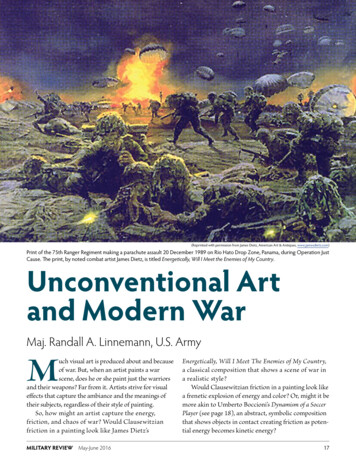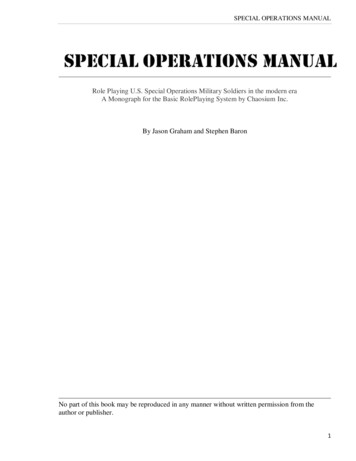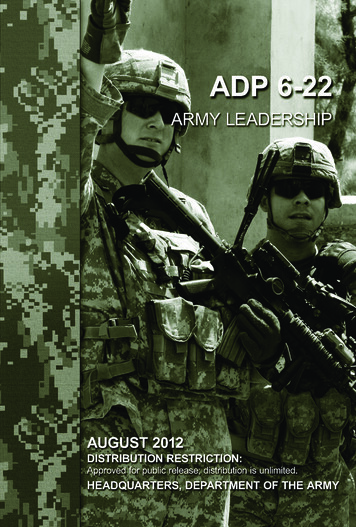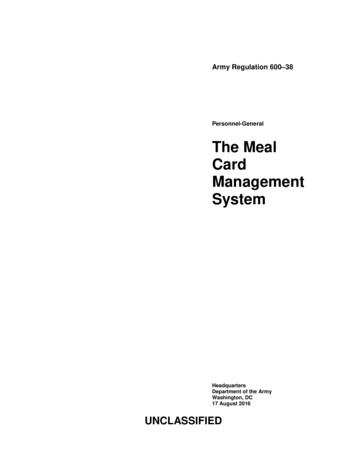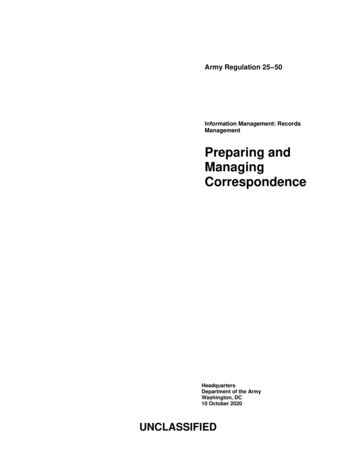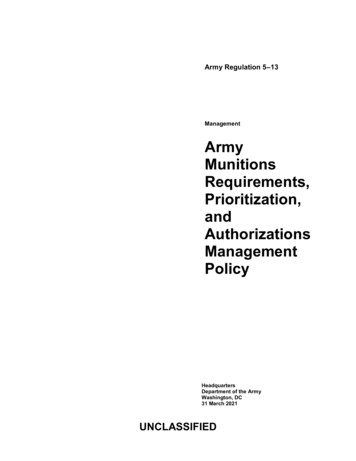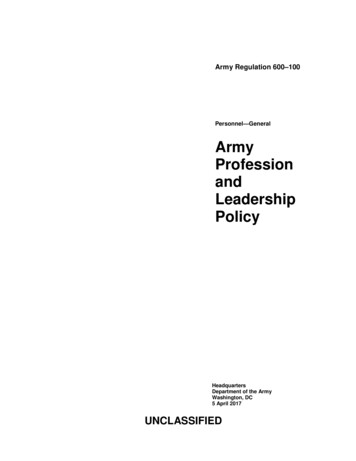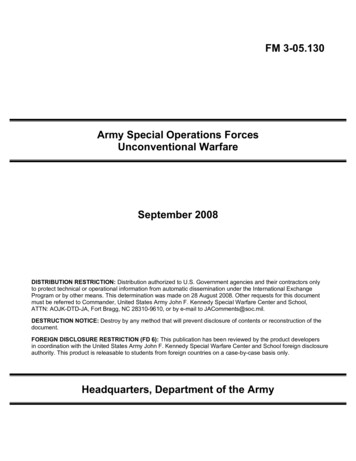
Transcription
FM 3-05.130Army Special Operations ForcesUnconventional WarfareSeptember 2008DISTRIBUTION RESTRICTION: Distribution authorized to U.S. Government agencies and their contractors onlyto protect technical or operational information from automatic dissemination under the International ExchangeProgram or by other means. This determination was made on 28 August 2008. Other requests for this documentmust be referred to Commander, United States Army John F. Kennedy Special Warfare Center and School,ATTN: AOJK-DTD-JA, Fort Bragg, NC 28310-9610, or by e-mail to JAComments@soc.mil.DESTRUCTION NOTICE: Destroy by any method that will prevent disclosure of contents or reconstruction of thedocument.FOREIGN DISCLOSURE RESTRICTION (FD 6): This publication has been reviewed by the product developersin coordination with the United States Army John F. Kennedy Special Warfare Center and School foreign disclosureauthority. This product is releasable to students from foreign countries on a case-by-case basis only.Headquarters, Department of the Army
This publication is available atArmy Knowledge Online (www.us.army.mil) andGeneral Dennis J. Reimer Training and DoctrineDigital Library at (www.train.army.mil).
FM 3-05.130HeadquartersDepartment of the ArmyWashington, DC, 30 September 2008Field ManualNo. 3-05.130Army Special Operations ForcesUnconventional WarfareContentsPagePREFACE.ivChapter 1INTRODUCTION . 1-1Overview. 1-1Unconventional Warfare . 1-2Conventional Warfare. 1-4Irregular Warfare . 1-5Chapter 2UNITED STATES NATIONAL POWER. 2-1The International Environment . 2-1Instruments of United States National Power. 2-1The Effectiveness of Integrated National Power . 2-14Chapter 3POLICY AND DOCTRINE. 3-1National Policy. 3-1Conventional Warfare and Major Combat Operations . 3-15Irregular Warfare . 3-21Chapter 4PLANNING CONSIDERATIONS . 4-1Unconventional Warfare Planning. 4-1Seven Phases of Unconventional Warfare. 4-5Unconventional Warfare Termination of Operations . 4-12Army Special Operations Forces. 4-14Supporting Elements and Activities. 4-20Interagency Activities. 4-20Distribution Restriction: Distribution authorized to U.S. Government agencies and their contractors only toprotect technical or operational information from automatic dissemination under the International ExchangeProgram or by other means. This determination was made on 28 August 2008. Other requests for this documentmust be referred to Commander, United States Army John F. Kennedy Special Warfare Center and School,ATTN: AOJK-DTD-JA, Fort Bragg, NC 28310-9610, or by e-mail to JAComments@soc.mil.Destruction Notice: Destroy by any method that will prevent disclosure of contents or reconstruction of thedocument.Foreign Disclosure Restriction (FD 6): This publication has been reviewed by the product developers incoordination with the United States Army John F. Kennedy Special Warfare Center and School foreign disclosureauthority. This product is releasable to students from foreign countries on a case-by-case basis only.i
ContentsChapter 5SPECIAL FORCES OPERATIONS . 5-1Introduction. 5-1Phase I: Preparation. 5-1Phase II: Initial Contact. 5-2Phase III: Infiltration. 5-2Phase IV: Organization. 5-3Phase V: Buildup . 5-6Phase VI: Employment . 5-7Phase VII: Transition . 5-8Chapter 6PSYCHOLOGICAL OPERATIONS . 6-1Introduction. 6-1Phase I: Preparation. 6-1Phase II: Initial Contact. 6-4Phase III: Infiltration. 6-5Phase IV: Organization. 6-6Phase V: Buildup . 6-9Phase VI: Employment . 6-11Phase VII: Transition . 6-12Chapter 7CIVIL AFFAIRS OPERATIONS. 7-1Introduction. 7-1Phase I: Preparation. 7-1Phase II: Initial Contact. 7-3Phase III: Infiltration. 7-4Phase IV: Organization. 7-5Phase V: Buildup . 7-6Phase VI: Employment . 7-6Phase VII: Transition . 7-10Chapter 8SUPPORTING ELEMENTS AND ACTIVITIES . 8-1Introduction. 8-1Communications Support . 8-1Logistics Support . 8-5Force Health Protection. 8-8Aviation Support . 8-11Appendix ATHE DIPLOMATIC INSTRUMENT OF NATIONAL POWER.A-1Appendix BTHE INFORMATIONAL INSTRUMENT OF NATIONAL POWER .B-1Appendix CTHE INTELLIGENCE INSTRUMENT OF NATIONAL POWER.C-1Appendix DTHE ECONOMIC INSTRUMENT OF NATIONAL POWER .D-1Appendix ETHE FINANCIAL INSTRUMENT OF NATIONAL POWER. E-1Appendix FTHE LAW ENFORCEMENT INSTRUMENT OF NATIONAL POWER . F-1Appendix GTHE MILITARY INSTRUMENT OF NATIONAL POWER .G-1Appendix HTHE ROLE OF HISTORY AND CULTURE .H-1Appendix IA HISTORICAL SURVEY OF UNCONVENTIONAL WARFARE . I-1Appendix JAN OUTLINE HISTORY OF THE UNCONVENTIONAL WARFAREDEFINITION . J-1iiFM 3-05.13030 September 2008
ContentsGLOSSARY .Glossary-1REFERENCES .References-1INDEX. Index-1FiguresFigure 1-1. Contrasting conventional and irregular warfare . 1-7Figure 1-2. Principles of major combat operations. 1-8Figure 1-3. Joint operating concept relationships. 1-9Figure 2-1. The intelligence process . 2-5Figure 4-1. Classic components of an insurgency in an unconventional warfareoperational area . 4-8Figure 6-1. Psychological Operations and Special Forces Soldiers building rapportwith an unconventional warfare force in Afghanistan . 6-6Figure 6-2. Afghan village elder addressing population on Psychological Operationsloudspeaker. 6-8Figure 7-1. Civil-military lines of operation in support of unconventional warfare. 7-2Figure 7-2. Active Army Civil Affairs battalion operational structure . 7-3Figure 7-3. Civil Affairs core tasks in support of civil-military operations . 7-4Figure 7-4. Sample checklist for transition planning.7-11Figure A-1. Organizations grouping almost all countries in their respective continents.A-7Figure A-2. Several smaller regional organizations with nonoverlapping memberships.A-8Figure A-3. Several nonoverlapping large alliances.A-8Figure B-1. The information environment.B-2Figure B-2. Information quality criteria .B-2TablesTable B-1. Information operations integration into joint operations. B-2030 September 2008FM 3-05.130iii
PrefaceField Manual (FM) 3-05.130, Army Special Operations Forces Unconventional Warfare, establishes keystonedoctrine for Army special operations forces (ARSOF) operations in unconventional warfare (UW). It is basedon lessons learned from both historical and contemporary UW operations. It is also based on existing,long-standing Army Special Forces (SF) UW doctrine; recently developed doctrine, such as counterinsurgency(COIN); and emerging affiliated concepts, such as irregular warfare (IW).PURPOSESince 11 September 2001 and the onset of the War on Terrorism (WOT), existing UW doctrinal publicationshave undergone intense scrutiny and timely revision. A majority of existing ARSOF manuals have incorporatedrecent lessons learned and updated tactics, techniques, and procedures (TTP) of immediate utility to the conductof war. For this reason, the Army has classified most of these revised manuals. UW remains an enduring andeffective means of warfighting and is recognized as a central effort in the WOT. Although the classification ofexisting doctrine is prudent for operational security, it limits the distribution of concepts necessary for aneffective joint, interagency, and multinational effort. ARSOF and other audiences require an unclassifiedconceptual manual useful to understanding the nature of UW and its role in the nation’s application of power.This manual provides that unclassified conceptual treatment.SCOPEARSOF execute and are the functional proponent for UW under United States Special Operations Command(USSOCOM) Directive 10-1, Terms of Reference for Component Commanders, and other authorities. Currently,there exists no authoritative interagency or joint doctrine specifically for UW—although sufficient jointdoctrine does exist for general campaign design and execution of joint and Army operations. This manual is theoverarching doctrinal reference that specifically addresses UW as conducted by ARSOF. Detailed TTP for UWcan be found in FM 3-05.201, (S/NF) Special Forces Unconventional Warfare (U).The first chapter establishes what UW is and includes a comparison of traditional and emerging concepts withwhich UW is sometimes confused. Chapter 2 discusses the international environment and United States (U.S.)instruments of national power within which all military operations—including UW—occur. Chapter 3 addressespolicy and doctrine that define, enable, and constrain UW. Chapter 4 outlines planning considerations for UW.The next three chapters provide a more focused operational discussion of ARSOF’s three main componentdisciplines: SF operations, Psychological Operations (PSYOP), and Civil Affairs operations (CAO). Chapter 8,which concerns supporting elements and activities of UW, concludes the basic manual. The appendixes containuseful supplemental information. The first seven appendixes (A–G) provide expanded and detailed informationon U.S. instruments of national power within the broader context of the international environment. Appendix His a survey of definitions and current academic considerations concerning historical and cultural concepts usefulto the assessment of human environments. Appendix I provides a historical survey of UW. Appendix J containsan outline sketch of change and constancy in the definition of UW. Current doctrinal references and anexpanded bibliography provide a guide for further reading and mature understanding of UW within theendeavor of war.Both the text and the Glossary identify terms that have joint or Army definitions. FM 3-05.130 is the proponentfield manual (the authority) for UW, but is not the proponent for any other Army term.APPLICABILITYThe primary audience for this manual is leaders and planners at all levels of ARSOF. The manual is useful to ajoint, interagency, and multinational audience that may collaborate with ARSOF in the conduct of UW. Thispublication applies to the Active Army, Army National Guard (ARNG)/Army National Guard of the UnitedStates, and United States Army Reserve (USAR) unless otherwise stated.ivFM 3-05.13030 September 2008
PrefaceADMINISTRATIVE INFORMATIONUnless this publication states otherwise, masculine nouns and pronouns do not refer exclusively to men. Theproponent of this manual is the United States Army John F. Kennedy Special Warfare Center and School(USAJFKSWCS). Submit comments and recommended changes to Commander, USAJFKSWCS,ATTN: AOJK-DTD-JA, Fort Bragg, NC 28310-9610, or by e-mail to JAComments@soc.mil.30 September 2008FM 3-05.130v
This page intentionally left blank.
Chapter 1IntroductionOVERVIEW1-1. Competition between contending groups using all their means of power has always characterized theinternational environment. In the modern era since the Treaty of Westphalia (1648), this competition hasgenerally been conceived as occurring between nation-states. Such competition involved all instruments ofstate power: diplomatic, informational, military, and economic (DIME) expanded in some recent policydocuments to diplomatic, informational, military, economic, financial, intelligence, and law enforcement(DIMEFIL). The overwhelming majority of these competitions were peaceful. Most often, nation-statesused the military instrument of power peacefully for static defense, as a force-in-being that enableddiplomatic posturing or a credible deterrent, or for essentially nonmilitary purposes, such as engineeringprojects or disaster relief. Only when other instruments of national power were exhausted or provedinadequate was the military instrument of power wielded to settle international differences. Claus vonClausewitz famously characterized such use of state military power as, “an act of violence to compel theenemy to do our will.” This assertion has been profoundly influential. However, it is too constrained of avision for applying national power in today’s world. The ancient Sun Tzu is more relevant today; althoughbattles should be won, “winning 100 victories in 100 battles is not the acme of skill; defeating the enemywithout fighting is the acme of skill.” There is more than one way to compel an enemy.1-2. Following the conventions of the time, the United States established a standing Continental Army ofuniformed regulars who, in combination with guerrilla raiders and a rebellious population, won Americanindependence. In the 19th century, the United States further developed its military power sufficient toexpand and defend a young continental nation. In the 20th century, the United States used its unparalleledmilitary power to successfully conclude two world wars and provide the credibility required to win a third(albeit “Cold”) war. The late 20th century understood the fullest manifestation of actual (or potential) warthus defined as the large-scale mobilization and total commitment of massive organizations wieldingimmense destructive power.1-3. The international environment in the 21st century, however, presents new challenges. The UnitedStates possesses overwhelming conventional military superiority, and other nation-states recognize that adirect military threat to the United States is a losing proposition. Therefore, large-scale and directconventional war against the United States is increasingly unlikely. Competition in the internationalenvironment using all instruments of power, however, remains timeless and continuous. Competitors nowconcentrate on the nonmilitary instruments of power in the natural intercourse between nations. Most suchintercourse remains peaceful and routine. Enemy competitors, however, use the instruments of power asweapons. Moreover, not all modern enemy competitors are synonymous with nation-states.1-4. International actors in the current era have awakened to the potential of such “unconventional”methods for compelling an enemy to do one’s will. Avoiding the advantages of U.S. military power, theseinternational actors seek to erode the ability of the United States to employ that comparative advantage.Using the other instruments of power—especially the informational—they seek to employ what is variablyreferred to as “irregular,” “asymmetric,” or “unrestricted” warfare. Even when violence is joined, directmethods are generally avoided for the classic techniques of guerrilla warfare, terrorism, sabotage,subversion, and insurgency.1-5. Such indirect methods are not unprecedented. Since ancient times, kingdoms and empires haveemployed psychological warfare to terrorize, demoralize, and subvert their opponents. Guerrillas haveattacked and sabotaged where possible to weaken a superior contending power. Combined with politicalpurpose, such guerrillas and political warriors have sought to resist the occupier, or subvert and overthrowthe oppressor. The postcolonial, modern era especially saw the widespread expansion of suchunconventional methods.30 September 2008FM 3-05.1301-1
Chapter 11-6. The United States is not unpracticed in using many of these methods. It is accustomed to wielding allinstruments of national power. It has effectively done so in the past. At the dawn of the 21st century, theUnited States still enjoys the largest economy in the world and continues to wield enormous economic andfinancial influence. The tangible and cultural products produced by the United States are spread across theplanet. In addition to its military power, the combined weight and multifaceted appeal of this nationaloutput enhances the influence of the diplomatic and informational message of the United States. U.S.military power guarantees and significantly enhances the rule of law in the international system. The reachof all these instruments is paralleled by intelligence and law-enforcement instruments that provide constantfeedback of information and respect for international codes of behavior.1-7. Failing a peaceful resolution of international competition, the United States has a tested militarycapability to use UW. Although such special operations (SO) are inherently joint missions of theUSSOCOM, the capability has traditionally and primarily resided in ARSOF. The spiritual forbearers ofAmerican UW can be traced to the colonial period. ARSOF has a direct military lineage of conducting UW,which dates back more than 50 years to the World War II (WWII) Office of Strategic Services (OSS). TheUnited States has conducted UW in support of resistance movements, insurgencies, and ongoing or pendingconventional military operations. It has operated by, with, or through irregular forces against a variety ofstate and nonstate opponents. Such sensitive operations are a high-value component and a specificapplication of the military instrument of national power. ARSOF UW—properly employed within thecontext of all such power effectively integrated—is more relevant than ever in the 21st centuryinternational environment.UNCONVENTIONAL WARFARE1-8. The definition of UW has evolved over time. The initial doctrinal concept for the United States toconduct UW originated with the creation of the OSS during WWII. In that classic context, UW wasgenerally defined in terms of guerrilla and covert operations in enemy-held or -influenced territory. Thefirst official Army definition that touched upon aspects of UW appeared in 1950 as “partisan warfare.” In1951, the Army’s UW assets were consolidated under the Office of Psychological Warfare, and the Armypublished the first two field manuals for the conduct of SO (with an emphasis on UW). By 1955, the firsthistorical manual that specifically linked Army SF to UW (FM 31-20, Special Forces Group) declared,“UW consists of the three interrelated fields of guerrilla warfare (GW), escape and evasion, and subversionagainst hostile states.”1-9. In the subsequent Cold War decades, the definition expanded and contracted, verbiage changed, andmissions conceived as a part of this unconventional enterprise were added or subtracted. The commonconceptual core has nevertheless remained as working by, with, or through irregular surrogates in aclandestine and/or covert manner against opposing actors. It is common for definitions to evolve, andARSOF have distilled the definition below to highlight the essentials of UW and eliminate the nonessential.In this era of definitional and conceptual change, ARSOF—and its joint, interagency, and multinationalpartners—must be unified with a clear and concise understanding of the UW core mission.1-10. The current definition of UW is as follows:Operations conducted by, with, or through irregular forces in support of a resistancemovement, an insurgency, or conventional military operations.FM 3-05.201, (S/NF) Special Forces Unconventional Warfare (U)28 September 2007This definition reflects two essential criteria: UW must be conducted by, with, or through surrogates; andsuch surrogates must be irregular forces. Moreover, this definition is consistent with the historical reasonsthat the United States has conducted UW. UW has been conducted in support of both an insurgency, suchas the Contras in 1980s Nicaragua, and resistance movements to defeat an occupying power, such as theMujahideen in 1980s Afghanistan. UW has also been conducted in support of pending or ongoingconventional military operations; for example, OSS/Jedburgh activities in France and OSS/Detachment 101activities in the Pacific in WWII and, more recently, SF operations in Operation ENDURING FREEDOM(OEF)/Afghanistan in 2001 and Operation IRAQI FREEDOM (OIF)/Iraq in 2003. Finally and in keepingwith the clandestine and/or covert nature of historical UW operations, it has involved the conduct of1-2FM 3-05.13030 September 2008
Introductionclassified surrogate operations. Details of classified operations are in FM 3-05.20, (C) Special ForcesOperations (U), and FM 3-05.201.1-11. The definition establishes a “litmus test” for clearly differentiating UW from other activities andclearly establishes the purpose for conducting UW. Including the idea of “by, with, or through surrogates”eliminates any confusion with unilateral direct action (DA), special reconnaissance (SR), orcounterterrorism (CT) missions. Identifying the historically demonstrated use of irregular forces assurrogates in the definition eliminates any confusion with foreign internal defense (FID) or coalitionactivities using regular forces. The clearly stated purpose of UW to support insurgencies, resistancemovements, and conventional military operations not only eliminates the possibility of incorrectlycharacterizing UW as solely an IW activity but also articulates UW’s relevance to the Army and joint forceby specifying support to other operations.Personnel should not confuse UW with other operations that involve indigenouspersonnel, such as FID. The United States characterizes FID as an overt, directmethod of assistance to free and protect a host nation (HN) government frominsurgency or lawlessness. Forces conduct FID with recognized HN regular forces.These forces are armed individuals or groups of individuals who are members of theregular armed force, police force, or other internal security force of that nation. Theremay be instances in which the United States or the HN overtly employs civilianpersonnel to enhance operational effectiveness; however, those personnel areopenly recognized as an augmentation to the regular forces of the HN.Army and joint doctrine currently do not define regulars, or regular forces. For use inthis manual, these forces are defined as being opposite of irregular forces. Regularsare armed individuals or groups of individuals who are members of a regular armedforce, police, or other internal security force. Once a nation charters or sponsors aforce to provide internal security, that force is considered to be a regular force.Regardless of its appearance or naming convention, if the force operates undergovernmental control, it is a regular force.Irregulars, or irregular forces, are individuals or groups of individuals who are notmembers of a regular armed force, police, or other internal security force. They areusually nonstate-sponsored and unconstrained by sovereign nation legalities andboundaries. These forces may include, but are not limited to, specific paramilitaryforces, contractors, individuals, businesses, foreign political organizations, resistanceor insurgent organizations, expatriates, transnational terrorism adversaries,disillusioned transnational terrorism members, black marketers, and other social orpolitical “undesirables.”1-12. However, the definition of UW is not simply a list of essential criteria and rationales connectedend-to-end. It is the most concise definition possible that allows for the essential UW criteria andrationales, and explicitly or implicitly answers the “who, what, when, where, and why” questions of amilitary definition. For example, working “by, with, or through” is having one act on the behalf of anotherso the commonly used concept of “surrogate” is implied. Moreover, the one on whose behalf action is takenimplies the “who” and is likewise unnecessary. The “what and why” questions are explicitly answered byUW’s purpose as stated above, and the “when and where” are implicit in the times and spaces the purposeis being pursued.1-13. Given the ongoing utility of UW in the WOT era, and in the context of the emerging IW effort, it isequally important to highlight what UW is not. It is not simply a catchall phrase for anything that is notconventional, regular, or traditional. It is synonymous neither with the emerging term “irregular warfare”nor with the currently influential (but nondoctrinal) terms “asymmetric warfare,” “unrestricted warfare,” or“fourth-generation warfare” (although there are conceptual similarities). Moreover, and despite widespreadconfusion outside of ARSOF, UW is not synonymous with either “special operations” or “guerrillawarfare.” All UW operations are special operations, but not all special operations are UW. Although GW is30 September 2008FM 3-05.1301-3
Chapter 1a classic inherent component of UW and is featured in many historical definitions, UW is an operation,whereas GW is a technique.CONV
Field Manual (FM) 3-05.130, Army Special Operations Forces Unconventional Warfare, . recent lessons learned and updated tactics, techniques, and procedures (TTP) of immediate utility to the conduct of war. For this reason, the Army has classified
